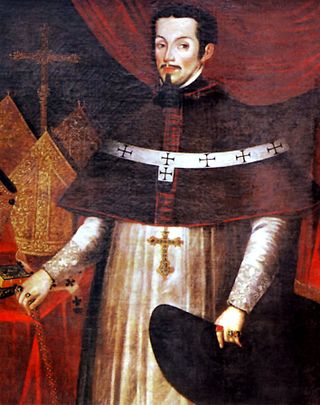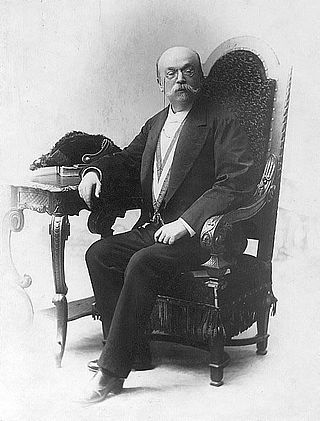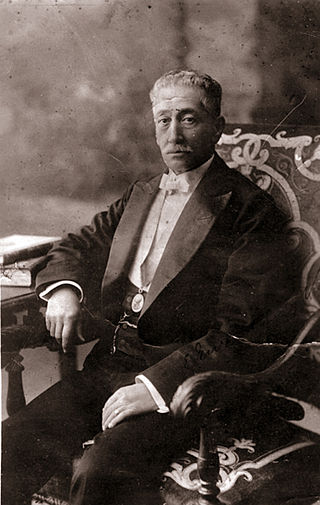Related Research Articles

The president of Peru, officially the constitutional president of the Republic of Peru, is the head of state and head of government of Peru. The president is the head of the executive branch and is the supreme head of the Armed Forces and National Police of Peru. The office of president corresponds to the highest magistracy in the country, making the president the highest-ranking public official in Peru.

Andrés de Santa Cruz y Calahumana was a Bolivian general and politician who served as interim president of Peru in 1827, the interim president of Peru from 1836 to 1838 and the sixth president of Bolivia from 1829 to 1839. He also served as Supreme Protector of the short-lived Peru-Bolivian Confederation from 1836 to 1839, a political entity created mainly by his personal endeavors.

José Balta y Montero was a Peruvian soldier and politician who served as the 19th President of Peru from 1868 to 1872. He was the son of John Balta Bru and Agustina Montero Casafranca.

Víctor Andrés Belaúnde Diez Canseco was a Peruvian diplomat, politician, philosopher and scholar. He chaired the 14th Session and the 4th Emergency Special Session of the United Nations General Assembly between 1959 and 1960 and was Minister of Foreign Affairs of Peru in 1958. A distinguished scholar, Belaúnde was an important catholic thinker and a professor at the San Marcos University and then at the Pontifical Catholic University of Peru, where he was Emeritus Rector.

The Chilean War of Independence was a military and political event that allowed the emancipation of Chile from the Spanish Monarchy, ending the colonial period and initiating the formation of an independent republic.

Francisco Antonio García Carrasco Díaz was a Spanish soldier and Royal Governor of Chile. His political relations with Juan Martinez de Rozas and a smuggling scandal involving the frigate Scorpion destroyed what little authority he had, and required that he surrender his post to Mateo de Toro Zambrano President of the first government board. He was the last governor to rule before the Chilean independence movement swept the country.

Melchor Liñán y Cisneros was a Roman Catholic prelate who served as Archbishop of Lima (1677–1708), Archbishop of La Plata o Charcas (1672–1675), Bishop of Popayán (1667–1672), and Bishop of Santa Marta (1664–1668). He also served as Viceroy of Peru from July 7, 1678, to November 20, 1681.

The First Government Junta of Chile, officially the Provisional Government Junta of the Kingdom in the name of Ferdinand VII, was the organization established to rule post-colonial Chile following the deposition and imprisonment of King Ferdinand VII of Spain by Napoleon Bonaparte. It was the earliest step in the Chilean struggle for independence, and the anniversary of its establishment is celebrated as the national day of Chile.

Francisco García Calderón Landa was a lawyer and Provisional President of the Republic of Peru for a short seven-month period in 1881, during the War of the Pacific. García Calderón was a key figure in the final peace accords between Peru and Chile. Later in post-presidential career, in 1892, he was commissioned to arbitrate land disputes between Peru and Ecuador, which centered on the contested provinces of Mainas, Jaén and Tumbes. He was an academic as well, having authored a comprehensive history of the previously-mentioned contested provinces, as well as a monograph on Peruvian legislation titled, Diccionario de la Legislación Peruana.
Mariano Eduardo de Rivero y Ustariz was a prominent Peruvian scientist, geologist, mineralogist, chemist, archaeologist, politician and diplomat. His publications about his discovery of Humboldtine, demonstrating the existence of organic-minerals; about deposits of copper and sodium nitrate (saltpeter) near Tarapacá in the Atacama Desert; about bird-guano and coal in Peru and their possibilities of industrialization as well were forward-looking and made him a pioneer of mining education in South America and the most notable Peruvian scientist of the 19th century.

José Hipólito Unanue y Pavón was a physician, naturalist, meteorologist, cosmographer, the first Minister of Finance of Peru, Minister of Foreign Affairs, Protomédico, university professor, founder of the San Fernando Medical School, representative of Arequipa in the Cortes of Cádiz, President of the Junta de Gobierno, Protector of the province of Arequipa, independence precursor and a Peruvian politician, active in politics in the early years after independence. He served as the President of the Congress from 1822 to 1823.

The Chief of the Cabinet of Ministers of the Argentine Nation, more commonly known simply as the Cabinet Chief is a ministerial office within the government of Argentina tasked with overseeing the government's general administration and acting as a link between the national executive and the Argentine National Congress. The position was created by the 1994 amendment to the Argentine Constitution.

Enrique Guzmán y Valle, was a Peruvian chemist and professor.

Antonio Herrera Toro was a Venezuelan painter, art critic and professor.

BAP Carrasco is an oceanographic research vessel of the Peruvian Navy built in 2016 by Freire Shipyard in Vigo (Spain). Its purpose is to perform oceanographic research cruises both in Peruvian waters and in Antarctica, in order to fulfill Peru's commitment under the Antarctic Treaty. The ship is endowed with technical capabilities for activities of hydrography, oceanography, marine meteorology, and marine geology. It also has polar capability and it is classified with PC7 notation. Since 2017 the ship has become the main platform for Peruvian annual expeditions to Antarctica.
João Baptista Lavanha was a Portuguese cartographer, mathematician and geographer in the service of the Spanish kings Philip II and Philip III.
Cristóbal de Losada y Puga was a Peruvian mathematician and mining engineer. He was Minister of Education of Peru in the government of José Luis Bustamante y Rivero and Director of the National Library of Peru between 1948 and 1961.

José Gabriel Gálvez Egúsquiza was a Peruvian lawyer, professor and liberal politician. During the presidential government of Mariano Ignacio Prado he was Secretary—i.e. Minister—of War and Navy (1865). He was killed in action during the Battle of Callao, where he died fighting the Spanish squadron, thus becoming a symbol of the independence of America.

Manuel María Gálvez Egúsquiza was a Peruvian lawyer, magistrate, university professor and politician.
Pedro Mariano Cabello (1811–1875) was a Peruvian academic and politician. He served as the penultimate Chief Cosmographer of the Republic of Peru.
References
- ↑ "ISSN 2306-1715 (Online) | Nueva corónica | The ISSN Portal". portal.issn.org. Retrieved 2024-12-30.
- ↑ "CONSTITUYENTES 1826" (PDF).
- ↑ "¿Por qué se nombró Carrasco al nuevo buque de la Marina?". El Comercio (in Spanish). 2017-05-03. ISSN 1605-3052 . Retrieved 2024-12-30.